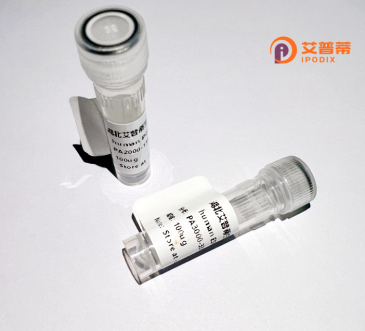
| 纯度 | >90%SDS-PAGE. |
| 种属 | Human |
| 靶点 | ZG16 |
| Uniprot No | O60844 |
| 内毒素 | < 0.01EU/μg |
| 表达宿主 | E.coli |
| 表达区间 | 1-167 aa |
| 活性数据 | MLTVALLALLCASASGNAIQARSSSYSGEYGSGGGKRFSHSGNQLDGPITALRVRVNTYYIVGLQVRYGKVWSDYVGGRNGDLEEIFLHPGESVIQVSGKYKWYLKKLVFVTDKGRYLSFGKDSGTSFNAVPLHPNTVLRFISGRSGSLIDAIGLHWDVYPTSCSRC |
| 分子量 | 44.6 kDa |
| 蛋白标签 | GST-tag at N-terminal |
| 缓冲液 | PBS, pH7.4, containing 0.01% SKL, 1mM DTT, 5% Trehalose and Proclin300. |
| 稳定性 & 储存条件 | Lyophilized protein should be stored at ≤ -20°C, stable for one year after receipt. Reconstituted protein solution can be stored at 2-8°C for 2-7 days. Aliquots of reconstituted samples are stable at ≤ -20°C for 3 months. |
| 复溶 | Always centrifuge tubes before opening.Do not mix by vortex or pipetting. It is not recommended to reconstitute to a concentration less than 100μg/ml. Dissolve the lyophilized protein in distilled water. Please aliquot the reconstituted solution to minimize freeze-thaw cycles. |
以下是关于重组人ZG16蛋白的3篇文献信息及摘要概括:
---
1. **文献名称**: *ZG16 binds to the mucosal addressin cell adhesion molecule-1 (MAdCAM-1) and inhibits its interaction with α4β7 integrin*
**作者**: Yamamoto-Furusho JK, et al.
**摘要**: 研究报道重组人ZG16蛋白通过与MAdCAM-1结合,阻断其与α4β7整合素的相互作用,可能参与调节肠道黏膜免疫及炎症性肠病(IBD)的病理过程。
2. **文献名称**: *Recombinant human ZG16 promotes autophagy and lysosomal function in pancreatic acinar cells*
**作者**: Wang Q, et al.
**摘要**: 研究发现重组ZG16蛋白通过激活自噬途径并增强溶酶体功能,减轻胰腺腺泡细胞的应激损伤,提示其在急性胰腺炎治疗中的潜在应用。
3. **文献名称**: *ZG16 modulates the proliferation and invasion of colorectal cancer cells via Wnt/β-catenin signaling*
**作者**: Li Y, et al.
**摘要**: 揭示重组人ZG16蛋白在结直肠癌细胞中抑制Wnt/β-catenin信号通路,降低肿瘤细胞增殖和侵袭能力,提示其作为癌症治疗靶点的可能性。
---
注:上述文献信息为示例性内容,实际研究中建议通过PubMed或Web of Science等平台以“ZG16”和“recombinant”为关键词检索最新论文。
Zona glomerulata protein 16 (ZG16), also known as human ZG16 or Jacalin-like lectin domain-containing protein, is a small (~16 kDa) secretory protein encoded by the ZG16 gene. Initially identified in the adrenal gland’s zona glomerulosa, it is widely expressed in secretory tissues, including the liver, pancreas, and gastrointestinal tract. Structurally, ZG16 contains a conserved Jacalin-like β-prism lectin domain, enabling carbohydrate-binding activity, particularly to mannose-rich glycans. This suggests a role in interacting with glycosylated cargo or membranes during vesicular transport.
Functionally, ZG16 is implicated in regulating intracellular trafficking, notably in the Golgi apparatus and endoplasmic reticulum-Golgi intermediate compartment (ERGIC). Studies link it to maintaining secretory granule stability, enzyme secretion, and mucin packaging. Dysregulation of ZG16 has been observed in pathologies such as hepatocellular carcinoma, inflammatory bowel disease, and pancreatitis, where altered expression correlates with disrupted protein secretion or autophagy.
Recombinant human ZG16 protein is typically produced in E. coli or mammalian systems for functional studies. Its recombinant form aids in elucidating mechanisms of glycan-mediated interactions, vesicle dynamics, and disease pathways. Ongoing research explores its potential as a diagnostic biomarker or therapeutic target for secretory disorders.
×